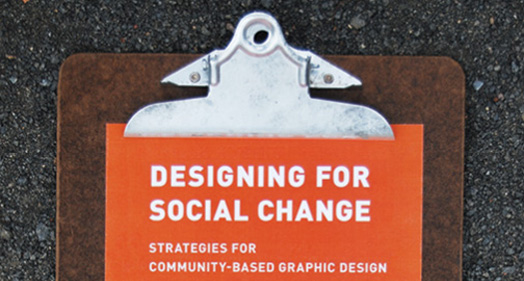
In June 2008 I attended a workshop called “Design for Social Impact” sponsored by the Rockefeller Foundation at its center on Lake Como in Bellagio, Italy. In this unusually bucolic setting in the southern Alps, twenty designers from a dozen countries pondered the question of whether design could be an avenue for poverty alleviation, and how such efforts could be organized into effective and impactful initiatives by design practitioners, firms, and organizations. This meeting marked the beginning of a personal journey that changed both my life and my work.
In previous years, most of my friends and peers participated in what was commonly referred to as “nonprofit work.” We might make our living producing branding for large companies, but we carved out a portion of our design practices to do “good work” — occasionally in our local communities, often for cultural organizations, and frequently with the sense that this was where our most creative opportunities lay. Such work was often done for no money or negligible fees: it was, quite literally, “nonprofit” work. Yet, this was the work that we entered in competitions, retained for our portfolios, and displayed proudly at conferences, forming the basis for many a creative reputation. It was graphic design doing good; Robin Hood stealing from the rich to help the poor; even a form of tithing, a ritualized percentage of our practice given back to God.
This approach to nonprofit design, whether engaged with ballet companies, local food banks, or voter registration initiatives, had another, darker side. It was often about the work we could showcase, not the people we were helping. It was often amateurish — designers making forays into education or health care with little practical knowledge or meaningful experience. It privileged the teacher, not the student; the client, not the user; the provider, not the person in need. It was too often design about design, design for the sake of design, designers preaching to one another about design’s capability to create impact.
At that Bellagio workshop I realized that design for social change could mean something very different. The participants talked about working with social enterprises, NGOs, foundations, corporations, and governments. We argued the vocabulary of social innovation, collaborative systems, and systemic change. We envisioned designing methods for poverty alleviation, social justice, and sustainable environments. And at every turn there were nagging questions, challenges without obvious answers. How do we capture innovations and replicate them? How do we move from effective programs to sustainable systems? Can we collaborate across the spectrum of design methodologies and genres to generate deeper, larger, longer-lasting solutions? How could such collaborations be organized, funded, and implemented? How could we measure our effectiveness, learn from our failures, and implement metrics for gauging sustained impact? How can we create programs and solutions of a scale commensurate with the scale of the actual problems confronting us?
I have since come to believe that social design defines a new kind of designer. It needs to be expansively conceived beyond trained designers to include end users and social participants. Social design cannot be a subspecialty of the design profession (like graphic design, package design, product design, service design, and so on), but is a larger activity that depends upon design in all its forms — thought, processes, tools, methodologies, skills, histories, systems—to contribute to the needs of a larger society. It implies at once an attitude and an approach to life: as such, it can help us frame how we want to live in the future. It is therefore inherently pragmatic and results-oriented, simultaneously humble and ambitious, and fundamentally optimistic and forward-looking.
So where do we start?
Designing for Social Change is one place to begin. It’s a toolkit of strategies, case studies, and stories, offering new opportunities for approaching social design in our communities. It presents students and schools as active participants, designers and design firms as social innovators, and communities as both rich laboratories for experimentation and receptive locations for creative approaches and new ideas. It includes successes and failures, and, with thoughtful reading, offers both evidence and learning that can inform future social design work and projects. Importantly, it suggests that collaboration between designers, and across schools and communities, has the potential to generate even more compelling future initiatives — and the potential for deeper design engagements that successfully impact the quality of life in our towns and cities. Designing for Social Change should be the guidebook of a youthful, nascent movement, one that is changing the definition and the role of design. As a designer, this is an exciting place to start.
This essay appears as the forward to Designing for Social Change: Strategies for Community-Based Graphic Design by Andrew Shea, published by Princeton Architectural Press earlier this month.


Comments [7]
"I have since come to believe that social design defines a new kind of designer. It needs to be expansively conceived beyond trained designers to include end users and social participants."
I would just like to add that inclusion is not just important/necessary. It is also a right. When we start to think about design from a rights-based approach it changes everything we do. The early part of your essay describes what I would call the charity model of design. This is the model where we get to feel good about our 'good works'. Also, as you put it: "It was often about the work we could showcase, not the people we were helping."
A rights-based approach would use design as a tool to promote and protect human rights in much the same way that lawyers can use the law to do the same thing. It is not about making us feel good about ourselves. It is about social change and how we can achieve that change. Design is most certainly an important tool in that.
Thanks for getting those thought out there.
Graeme Bristol
Centre for Architecture and Human Rights
03.23.12
10:00
03.24.12
02:13
03.26.12
12:37
Bill-
I just hope you see the irony in sitting at Bellagio on Lake Como while thinking about design as an avenue for "poverty alleviation." Then, too, PAP, and all of the institutional associations and programs represented by author, illustrator, and friends, is hardly an altruistic undertaking.
If there's one thing Kony 2012 has taught us, as eloquently stated in the Atlantic by Teju Cole, it's that we absolutely must free ourselves from the "white saviour industrial complex," whether profit or non-profit, designer or grant writer.
That social awareness has finally caught up with design is a given. What we do from this point will make all the difference.
03.27.12
08:22
One cannot attend Rockefeller's Bellagio, perched on the side of Lake Como — and clearly one of the most beautiful settings in the world — without a certain sense of irony about discussions of poverty alleviation. Whenever I speak, there is a visual juxtaposition of showing photos of Bellagio while talking about poverty: I'm sorry that irony was lost in my essay.
I've been to Bellagio twice, and both times the widely international participants and viewpoints made me thankful that I'd made the journey.
I'm glad that you have written to me separately to mention the Arundhati Roy article which looks at the history of aid and philanthropy from an Indian perspective.
“Capitalism: A Ghost Story” by Arundhati Roy:
https://revolutionaryfrontlines.wordpress.com/2012/03/17/capitalism-a-ghost-story-by-arundhati-roy/
04.04.12
02:44
05.03.12
12:13
09.15.12
04:45